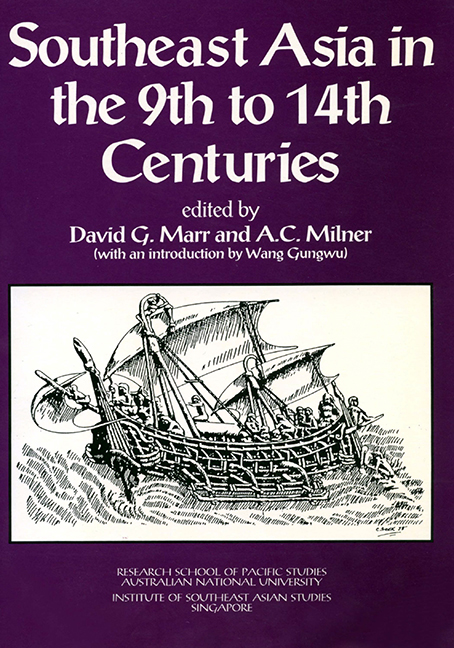Book contents
- Frontmatter
- Contents
- Contributors
- Preface
- Introduction
- 1 The Early and the Imperial Kingdom in Southeast Asian History
- 2 Hydraulic Works and South East Asian Polities
- 3 Some Notes on Relations between Central and Local Government in Ancient Java
- 4 Negara, Mandala, and Despotic State: Images of Early Java
- 5 Some Remarks on Early State Formation in Cambodia
- 6 “Elephants Can Actually Swim”: Contemporary Chinese Views of Late Ly Dai Viet
- 7 Authority and Legitimacy in 11th Century Vietnam
- 8 From Myth to History: Imagined Polities in 14th Century Vietnam
- 9 Shipshape Societies: Boat Symbolism and Political Systems in Insular Southeast Asia
- 10 Changing Perspectives in Island Southeast Asia
- 11 Political and Cultural Continuities at Dvaravati Sites
- 12 The True and the Corbel Arch in Mainland Southeast Asian Monumental Architecture
- 13 Vietnamese Ceramics and Cultural Identity: Evidence from the Ly and Tran Dynasties
- 14 Traditions, Acculturation, Renovation: The Evolutional Pattern of Vietnamese Culture
- 15 Symbolism of Kingship in Arakan
- 16 Buddhism in Champa
- 17 The Ordering of Generations: Change and Continuity in Old Javanese Kinship
- 18 Sources on Economic Activities in Khmer and Cham Lands
- 19 Narrative Bas-Reliefs at Candi Surawana
- 20 Possibilities for a Reading of the 1293-1357 Period in the Vietnamese Annals
- Index
- Miscellaneous Endmatter
15 - Symbolism of Kingship in Arakan
Published online by Cambridge University Press: 21 October 2015
- Frontmatter
- Contents
- Contributors
- Preface
- Introduction
- 1 The Early and the Imperial Kingdom in Southeast Asian History
- 2 Hydraulic Works and South East Asian Polities
- 3 Some Notes on Relations between Central and Local Government in Ancient Java
- 4 Negara, Mandala, and Despotic State: Images of Early Java
- 5 Some Remarks on Early State Formation in Cambodia
- 6 “Elephants Can Actually Swim”: Contemporary Chinese Views of Late Ly Dai Viet
- 7 Authority and Legitimacy in 11th Century Vietnam
- 8 From Myth to History: Imagined Polities in 14th Century Vietnam
- 9 Shipshape Societies: Boat Symbolism and Political Systems in Insular Southeast Asia
- 10 Changing Perspectives in Island Southeast Asia
- 11 Political and Cultural Continuities at Dvaravati Sites
- 12 The True and the Corbel Arch in Mainland Southeast Asian Monumental Architecture
- 13 Vietnamese Ceramics and Cultural Identity: Evidence from the Ly and Tran Dynasties
- 14 Traditions, Acculturation, Renovation: The Evolutional Pattern of Vietnamese Culture
- 15 Symbolism of Kingship in Arakan
- 16 Buddhism in Champa
- 17 The Ordering of Generations: Change and Continuity in Old Javanese Kinship
- 18 Sources on Economic Activities in Khmer and Cham Lands
- 19 Narrative Bas-Reliefs at Candi Surawana
- 20 Possibilities for a Reading of the 1293-1357 Period in the Vietnamese Annals
- Index
- Miscellaneous Endmatter
Summary
The kings of the obscure “Indianized” states of Arakan shared with their grander counterparts in Asia the need to explicate the link between their temporal position and the cosmological justification of their power. Their “oriental despotism” classically depended on the capability to control water. The agricultural base of the capitals from the 4th to the 18th centuries, the deltaic plains of the Kaladan and Lemro rivers, was swamped with water during the wet season but was dry for half the year. Surplus production could be maintained only through centralized water retention and drainage systems. The importance of a continued water supply is, naturally, the central motif of royal symbolism. The king's law, his dharma, was explained in terms of the cosmic law which guides the cycle of the seasons and guarantees fertility and prosperity.
While this theme has been explored time and again in Southeast Asian studies, two interesting illustrations show localized adaptation of Indian models: an inscribed stone with possible megalithic precedents, which had great significance for at least four dynasties between the 5th and 16th centuries, and remains important today, and two sculptures which we postulate represent Indra, king of the gods and bestower of water, whose celebrations are central to the Arakanese and Burmese new year festivities.
The Shitthaung Pillar
The city of Mrohaung (Ar. Mrauk-Ū), founded in 1430, was the last in a series of capitals along the Kaladan river, dating from around the 5th century. The Kaladan gives easy access to the Bay of Bengal, and the Arakanese capitals variously exhibit Gupta, Pallava, Pala and Moghul influence, although the impact of the Pyu and Mon-Burman cultures of Burma proper is also apparent.
The Shitthaungpara (Shrine of the Eighty Thousand Images) [1] was erected by King Minbin, (Sīrisuriyacandramahādhammarāja, fl. 1531-1553), twelfth king of the Mrauk-Ū dynasty, with the assistance of Bengali and Portuguese architects and engineers. Both a fortress and a pagoda, its purpose was to serve as a place of refuge for the royal family and retainers. By the time of its erection, the threat from both the Dutch and the Portuguese was very real, Mrauk-Ū being, in the words of the Viceroy of Goa “both rich and weak, and therefore desirable”. To the left hand of the entrance to the north side is a square stone pillar, rising to a height of 3.3 m from the socket, each side measuring 0.7 m across.
- Type
- Chapter
- Information
- Southeast Asia in the 9th to 14th Centuries , pp. 279 - 288Publisher: ISEAS–Yusof Ishak InstitutePrint publication year: 1986

